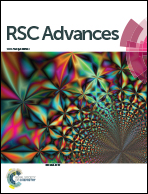Fabrication of plasmonic dye-sensitized solar cells using ion-implanted photoanodes†
Abstract
Plasmonic dye-sensitized solar cells containing metal nanoparticles suffer from stability issues due to their miscibility with liquid iodine-based electrolytes. To resolve the stability issue, herein, an ion implantation technique was explored to implant metal nanoparticles inside TiO2, which protected these nanoparticles with a thin coverage of TiO2 melt and maintained the localized surface plasmon resonance oscillations of the metal nanoparticles to efficiently enhance their light absorption and make them corrosion resistant. Herein, Au nanoparticles were implanted into the TiO2 matrix up to the penetration depth of 22 nm, and their influence on the structural and optical properties of TiO2 was studied. Moreover, plasmonic dye-sensitized solar cells were fabricated using N719 dye-loaded Au-implanted TiO2 photoanodes, and their power conversion efficiency was found to be 44.7% higher than that of the unimplanted TiO2-based dye-sensitized solar cells due to the enhanced light absorption of the dye molecules in the vicinity of the localized surface plasmon resonance of Au as well as the efficient electron charge transport at the TiO2@Au@N719/electrolyte interface.



 Please wait while we load your content...
Please wait while we load your content...